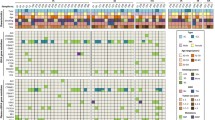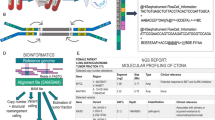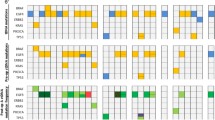Abstract
Detection of circulating tumor DNA (ctDNA) from plasma cell free DNA (cfDNA) has shown promise for diagnosis, therapeutic targeting, and prognosis. This study explores ctDNA detection by next generation sequencing (NGS) and associated clinicopathologic factors in patients with pancreatic adenocarcinoma (PDAC). Patients undergoing surgical exploration or resection of pancreatic lesions were enrolled with informed consent. Plasma samples (4–6 ml) were collected prior to surgery and cfDNA was recovered from 95 plasma samples. Adequate cfDNA for NGS (20 ng) was obtained from 81 patients. NGS was performed using the Oncomine Lung cfDNA assay on the Ion Torrent S5 sequencing platform. Twenty-five patients (30.9%) had detectable mutations in KRAS and/or TP53 with allele frequencies ranging from 0.05 to 8.5%, while mutations in other genes were detected less frequently and always along with KRAS or TP53. Detectable ctDNA mutations were more frequent in patients with poorly differentiated tumors, and patients without detectable ctDNA mutations showed longer survival (medians of 10.5 months vs. 18 months, p = 0.019). The detection of circulating tumor DNA in pancreatic adenocarcinomas is correlated with worse survival outcomes.
Similar content being viewed by others
Introduction
Pancreatic adenocarcinoma (PDAC) is a leading cause of cancer deaths and is often detected in advanced stages when it is often inoperable1. The median overall survival in patients with pancreatic adenocarcinoma is approximately 7 months, with significantly better survival in patients with resectable tumors2. One of the only ways to provide an opportunity of long-term survival is surgical removal of the tumor with adjuvant chemotherapy. While surgical technique has advanced, many patients are still surgically unresectable or on the borderline of resectability3.
The most common genetic alterations in pancreatic ductal adenocarcinoma are mutations in KRAS and TP53, as well as less prevalent alterations in other driver genes such as CDKN2A, SMAD4, and in DNA damage repair genes4. KRAS mutations are present in up to 95% of pancreatic adenocarcinomas while TP53 alterations can be detected in up to 75%5.
Detection of circulating tumor DNA (ctDNA) from plasma cell free DNA (cfDNA) has shown promise for diagnosis, therapeutic targeting, and monitoring of pancreatic adenocarcinoma6,7. Multiple extraction methods and platforms including digital droplet PCR and next generation sequencing have been designed for detection of ctDNA with differing detection rates, input DNA requirements, and sensitivities8,9,10. These techniques have shown good concordance with matched tumor controls and a tendency to correlate with poorer overall survival8,9,11,12. The post-operative detection of ctDNA has also been associated with higher recurrence rates and worse outcomes13. ctDNA detection may also shed light on tumor evolution over time7.
This study explores clinicopathologic factors associated with ctDNA detection in patients with pancreatic ductal adenocarcinomas.
Materials and methods
Patient selection and plasma collection
This study received ethical approval from the Institutional Review Board of NorthShore University HealthSystem (Approval EH16-083). All methods were performed in accordance with the relevant guidelines and regulations. Patients who underwent surgical exploration or resection of pancreatic lesions from 2007 to 2014 were enrolled in this study with informed consent which was contained from the subjects, with samples collected into the institutional biorepository. Eight to twelve ml EDTA blood was collected from 3 h to 2 weeks prior to surgery. Most specimens were collected at the primary hospital and centrifuged (1200 g, 10 min) and the plasma stored at − 80 °C within 2 h until cell-free DNA isolation, though some samples were sent from other hospitals. All were processed within 24 h. Patients with pancreatic ductal adenocarcinoma were subsequently selected for inclusion. Pathological and clinical staging parameters and outcomes were obtained via the electronic medical record.
Plasma cell free DNA recovery
cfDNA was recovered from 4 to 6 ml of plasma using a column purification method optimized to enrich for circulating cfDNA (Zymo Research Quick-cfDNA™ Serum & Plasma Kit, Irvine, CA) and further concentrated using the DNA Clean & Concentrator (Zymo Research). Cell free DNA recovery was assessed using the 4200 TapeStation (Agilent Technologies, Santa Clara, CA).
FFPE DNA extraction
Selected cases with adequate tumor tissue and representing all tumor grades, stages, and survival times were collected. Tissues were selected from patients with and without identified ctDNA mutations. DNA was extracted using the Pinpoint Slide DNA Isolation System (Zymo Research).
Next generation sequencing (NGS)
18.9–50.0 ng of input cfDNA was evaluated using the Oncomine™ Lung cfDNA Assay (ThermoFisher, Waltham, MA) on the Ion Torrent S5 sequencing platform. This is a limited, hotspot panel that was available at the time, in use in the lab, and optimized to enable sensitive detection of low level mutations in ctDNA and includes hotspots in ALK, BRAF, EGFR, ERBB2, KRAS, MAP2K1, MET, NRAS, PIK3CA, ROS1, and TP53, with interpretation focused on pathogenic variants in KRAS and TP53. Samples were sequenced to a mean depth of coverage of 17,589–113,777 × and a unique molecular coverage of 2276–11,382x. A 30–50 ng input with 4000 × molecular coverage provides a sensitivity down to 0.05% variant allele fraction. Additionally, 0.1% multiplex I cfDNA HD779 (Horizon Discovery, St Louis, MO) cfDNA reference standards were sequenced as a comparison.
Tissue DNA was sequenced using our in-house clinical Cancer HotSpot panel using the Ion AmpliSeq™ Cancer Hotspot Panel v2 (ThermoFisher) and an in-house bioinformatics pipeline14.
Statistical analyses
Statistical analyses using the Chi-squared test, Fisher’s exact test, Mann–Whitney U test, and linear regression were utilized for correlation of clinical and pathologic parameters. A multivariable Cox proportional hazards model was used to test the association between mutation status and survival time. The model included adjustment for tumor stage, age, and sex. Analyses were conducted using RStudio version 2022.2.0.443 and a p-value of 0.05 was used to determine statistical significance.
Results
Ninety-five patients were enrolled into this study and plasma specimens were obtained (Table 1). cfDNA was successfully extracted from EDTA preserved plasma and 81 samples yielded 18–50 ng of input DNA for NGS. A median of 37.3 ng of cfDNA was extracted from 4 to 6 ml of plasma, with a range of 6.8–836.8 ng (Fig. 1).
By next generation sequencing, mutations in KRAS and TP53 were detected in 25 of the 81 specimens (30.9%). KRAS mutations were detected in 10 (12.3%) and TP53 mutations in 18 (22.2%) of cell-free DNA samples, including 3 samples with both KRAS and TP53 mutations. Allele frequencies detected ranged from 0.05 to 8.55% (Table 1). Since samples negative for KRAS and TP53 were also negative for other gene mutations, we only reported the 2 genes.
Associations between assay parameters
There was no difference in the total cfDNA obtained from samples with detected or undetected circulating tumor DNA. There was no association between the amount of cfDNA obtained, ctDNA detection, and plasma volume (Table 2, S1 figure). The median depth of coverage was not significantly associated with total input cfDNA, but was associated with sequencing input and library ratios in pooling (S2 figure).
Clinico-pathologic associations
Detectable ctDNA mutations in KRAS and TP53 were more frequent in patients with poorly differentiated tumors (p < 0.001, Fig. 2). Tumor stage did not significantly influence detection of ctDNA mutations and no significant association was demonstrated between tumor stage and tumor grade (p = 0.90). Neoadjuvant status was not significantly associated with detection of ctDNA mutations (S2 Table).
The multivariable Cox model shows that detection of KRAS or TP53 mutations in cfDNA were associated with survival outcome independent of tumor stage, age, and sex (medians of 10.5 vs 18 months, p = 0.019, Tables 1 and 2; Kaplan Meier curves presented in Fig. 2). Although tumor stage was associated with survival outcome (p < 0.001), it was not significantly associated with mutation detection.
Association with tissue sequencing
DNA from 18 FFPE tissue specimens with adequate tissue were extracted and sequenced. KRAS alterations were detected in 17 of 18 cases and TP53 alterations in 8 of 18 cases (S1 Table). In 12 cases of 18 cases showing either a KRAS or TP53 mutation in the tissue specimen, there were no detectable mutations in cfDNA.
In six cases with detectable ctDNA mutations, four showed concurrent KRAS mutations in the tumor, and 2 cases showed TP53 ctDNA mutation which was not present in the tumor. In 12 cases with no detectable mutations in cfDNA, all cases demonstrated either a KRAS or TP53 mutation in the tissue specimen.
Discussion
The detection rate of our ctDNA assay in this study is in line with previously published studies, including input cfDNA amounts and depth of coverage achieved. Multiple studies report a wide range of ctDNA mutation detection rates, from 12.5 to 88% using a single strand library preparation method15,16,17. The wide range can be partially attributed to variable methodologies (ddPCR, amplicon-based NGS, capture-based NGS, cell-free DNA extraction, plasma volume, input DNA amount) and patient cohorts (cancer stage, tumor volume)18,19. However, use for screening purposes will require improved sensitivity as even the combination of one method of ctDNA detection with four protein biomarkers resulted in a sensitivity of only 64%20. In this study, under 25% of the cohort had metastatic pancreatic adenocarcinoma, leading to a somewhat lower incidence of detectable mutations than expected in a study of metastatic patients.
The concordance between tissue and ctDNA mutations showed similar sensitivity with the entire cohort and confirmed the presence of identical KRAS alterations in all cases with KRAS alterations in ctDNA. On the other hand, two cases with detectable TP53 in ctDNA did not have corresponding alterations in tumor tissue; these TP53 mutations may be derived from other sources. Studies of clonal hematopoiesis have frequently detected TP53 alterations detectable in cfDNA21.
The comparison of clinicopathologic parameters with ctDNA mutation status reveals a significant association of mutation status with both tumor grade and overall survival. Tumor necrosis has been associated with circulating tumor DNA and a correlation between tumor grade and necrosis was demonstrated in pancreatic ductal adenocarcinomas, which was also associated with patient survival22. Studies have also shown a relationship between tumor size, CA19-9 level, stage, and tumor volume on imaging with detection of ctDNA mutations13,18,23. The lack of a correlation between stage and detection of ctDNA mutations in our cohort may be due to the relatively low number of stage I patients and a larger number of stage IIB and stage IV cases in our patient population (S3 and S4 figure). However, stage was still an independent predictor of outcomes in our cohort even though it was not associated with ctDNA detection (Table 3).
The association of ctDNA mutation status with survival outcomes has been noted in a number of studies8,9,12,17,24, and post-operative detection of ctDNA mutations has also been reported as a predictor for recurrence11,13. Similar findings have been noted in other cancer types including colorectal25 and breast cancers26,27, highlighting the biological plausibility of ctDNA mutation status as an additional independent predictor of patient outcomes. This could represent a valuable tool for treatment decisions, particularly for malignancies such as PDAC which require surgical interventions that carry a high morbidity risk. However, prospective validation of this tool is required.
This study utilized banked specimens collected from 2007 to 2014. Our understanding of the impact of preanalytic parameters in the collection, processing, and storage on the recovery of ctDNA has greatly evolved in recent years28,29 However…add here.
Additionally, this study only compared the retrospective evaluation of patient clinico-pathologic data and pre-surgical plasma collection at a single time point. Other investigators have detected ctDNA prior to recurrence or progression using serial ctDNA measurements13,30.
Conclusions
Detection of ctDNA mutations in PDAC is a promising test which requires further prospective validation as a predictive and prognostic tool to assist in patient care decisions.
Data availability
The datasets generated during and/or analyzed during the current study are not publicly available due to institutional data policies but are available from the corresponding author on reasonable request. Sequencing data has been deposited the NCBI repository (http://www.ncbi.nlm.nih.gov/bioproject/1046660).
References
Siegel, R. L., Miller, K. D. & Jemal, A. Cancer statistics, 2020. CA Cancer J Clin. 70(1), 7–30 (2020).
Popiela, T. & Sierzeg, M. Temporal trends in pancreatic cancer. Pancreat Cancer Clin. Manag. 2012 (2012).
Strobel, O., Neoptolemos, J., Jäger, D. & Büchler, M. W. Optimizing the outcomes of pancreatic cancer surgery. Nat. Rev. Clin. Oncol. 16(1), 11–26. https://doi.org/10.1038/s41571-018-0112-1 (2019).
The Cancer Genome Atlas Network. Integrated genomic characterization of pancreatic ductal adenocarcinoma. Cancer Cell. 32(2), 185–203 (2017).
Cicenas, J., Kvederaviciute, K., Meskinyte, I., Meskinyte-Kausiliene, E. & Skeberdyte, A. KRAS, TP53, CDKN2A, SMAD4, BRCA1, and BRCA2 mutations in pancreatic cancer. Cancers (Basel). 9(5), 42 (2017).
Vietsch, E. E., van Eijck, C. H. & Wellstein, A. Circulating DNA and Micro-RNA in patients with pancreatic cancer. Pancreat. Disord. Ther. 5(2), 2964–2979 (2015).
Sivapalan, L. et al. Longitudinal profiling of circulating tumour DNA for tracking tumour dynamics in pancreatic cancer. BMC Cancer. 22(1), 1–17. https://doi.org/10.1186/s12885-022-09387-6 (2022).
Zill, O. A. et al. Cell-free DNA next-generation sequencing in pancreatobiliary carcinomas. Cancer Discov. 5(10), 1040–1048 (2015).
Singh, N., Gupta, S., Pandey, R. M., Chauhan, S. S. & Saraya, A. High levels of cell-free circulating nucleic acids in pancreatic cancer are associated with vascular encasement, metastasis and poor survival. Cancer Invest. 33(3), 78–85 (2015).
Takai, E. et al. Clinical utility of circulating tumor DNA for molecular assessment in pancreatic cancer. Sci. Rep. 5, 1–10. https://doi.org/10.1038/srep18425 (2015).
Lee, B. et al. Circulating tumor DNA as a potential marker of adjuvant chemotherapy benefit following surgery for localized pancreatic cancer. Ann. Oncol. 30(9), 1472–1478 (2019).
Uesato, Y. et al. Evaluation of circulating tumor DNA as a biomarker in pancreatic cancer with liver metastasis. PLoS One. 15(7), 1–13. https://doi.org/10.1371/journal.pone.0235623 (2020).
Groot, V. P. et al. Circulating tumor DNA as a clinical test in resected pancreatic cancer. Clin. Cancer Res. 25(16), 4973–4984 (2019).
Helseth, D. L. et al. Flype: Software for enabling personalized medicine. Am. J. Med. Genet. Part C Semin. Med. Genet. 187(1), 37–47 (2021).
Gall, T. M. H. et al. Can we predict long-term survival in resectable pancreatic ductal adenocarcinoma?. Oncotarget. 10(7), 696–706 (2019).
Liu, X. et al. Enrichment of short mutant cell-free DNA fragments enhanced detection of pancreatic cancer. EBioMedicine. 41, 345–356. https://doi.org/10.1016/j.ebiom.2019.02.010 (2019).
Sivapalan, L., Kocher, H. M., Ross-Adams, H. & Chelala, C. Molecular profiling of ctDNA in pancreatic cancer: Opportunities and challenges for clinical application. Pancreatology. 21(2), 363–378. https://doi.org/10.1016/j.pan.2020.12.017 (2021).
Strijker, M. et al. Circulating tumor DNA quantity is related to tumor volume and both predict survival in metastatic pancreatic ductal adenocarcinoma. Int. J. Cancer. 146(5), 1445–1456 (2020).
Grunvald, M. W., Jacobson, R. A., Kuzel, T. M., Pappas, S. G. & Masood, A. Current status of circulating tumor dna liquid biopsy in pancreatic cancer. Int. J. Mol. Sci. 21(20), 1–15 (2020).
Cohen, J. D. et al. Combined circulating tumor DNA and protein biomarker-based liquid biopsy for the earlier detection of pancreatic cancers. Proc. Natl. Acad. Sci. U S A. 114(38), 10202–10207 (2017).
Chan, H. T., Chin, Y. M., Nakamura, Y. & Low, S. K. Clonal hematopoiesis in liquid biopsy: From biological noise to valuable clinical implications. Cancers (Basel). 12(8), 1–18 (2020).
Hiraoka, N. et al. Tumour necrosis is a postoperative prognostic marker for pancreatic cancer patients with a high interobserver reproducibility in histological evaluation. Br. J. Cancer. 103(7), 1057–1065. https://doi.org/10.1038/sj.bjc.6605854 (2010).
Patel, H. et al. Clinical correlates of blood-derived circulating tumor DNA in pancreatic cancer. J. Hematol. Oncol. 12(1), 1–12 (2019).
Chen, L. et al. Prognostic value of circulating cell-free DNA in patients with pancreatic cancer: A systemic review and meta-analysis. Gene. 679, 328–334. https://doi.org/10.1016/j.gene.2018.09.029 (2018).
Fan, G. et al. Prognostic value of circulating tumor DNA in patients with colon cancer: Systematic review. PLoS One. 12(2), 1–17 (2017).
Papakonstantinou, A. et al. Prognostic value of ctDNA detection in patients with early breast cancer undergoing neoadjuvant therapy: A systematic review and meta-analysis. Cancer Treat. Rev. 104, 102362 (2022).
Cullinane, C. et al. Association of circulating tumor DNA with disease-free survival in breast cancer: A systematic review and meta-analysis. JAMA Netw. Open. 3(11), 1–10 (2020).
El Messaoudi, S., Rolet, F., Mouliere, F. & Thierry, A. R. Circulating cell free DNA: Preanalytical considerations. Clin. Chim. Acta. 424, 222–230 (2013).
Koessler, T., Addeo, A. & Nouspikel, T. Implementing circulating tumor DNA analysis in a clinical laboratory: A user manual. In Advances in Clinical Chemistry 1st edn, Vol. 89 131–188 (Elsevier Inc., 2019).
Sugimori, M. et al. Quantitative monitoring of circulating tumor DNA in patients with advanced pancreatic cancer undergoing chemotherapy. Cancer Sci. 111(1), 266–278 (2020).
Acknowledgements
We would like to thank the patients treated at NorthShore who agreed to have their samples deposited in the NorthShore Biospecimen Repository. Studies such as this one would not be possible without them.
Author information
Authors and Affiliations
Contributions
L.M.S., K.A.M., M.S.T. and K.L.K. conceived the design of this study. T.T., M.A., L.M.S., K.A.M., N.J., M.S.T. and J.S.J. were involved with patient sample collection, patient data collection, and molecular data collection. T.T., M.A., and A.F. were involved with data analysis. T.T., M.A., L.M.S., K.A.M., and K.L.K. were involved in the preparation of this manuscript.
Corresponding author
Ethics declarations
Competing interests
The authors declare no competing interests.
Additional information
Publisher's note
Springer Nature remains neutral with regard to jurisdictional claims in published maps and institutional affiliations.
Supplementary Information
Rights and permissions
Open Access This article is licensed under a Creative Commons Attribution 4.0 International License, which permits use, sharing, adaptation, distribution and reproduction in any medium or format, as long as you give appropriate credit to the original author(s) and the source, provide a link to the Creative Commons licence, and indicate if changes were made. The images or other third party material in this article are included in the article's Creative Commons licence, unless indicated otherwise in a credit line to the material. If material is not included in the article's Creative Commons licence and your intended use is not permitted by statutory regulation or exceeds the permitted use, you will need to obtain permission directly from the copyright holder. To view a copy of this licence, visit http://creativecommons.org/licenses/by/4.0/.
About this article
Cite this article
Theparee, T., Akroush, M., Sabatini, L.M. et al. Cell free DNA in patients with pancreatic adenocarcinoma: clinicopathologic correlations. Sci Rep 14, 15744 (2024). https://doi.org/10.1038/s41598-024-65562-8
Received:
Accepted:
Published:
DOI: https://doi.org/10.1038/s41598-024-65562-8
- Springer Nature Limited






